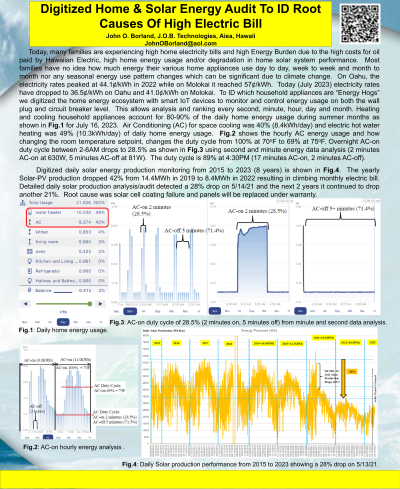Back

Electrification
Digitized High Home Energy Usage (Audit) to ID Root Cause for Corrective Action
Tuesday, September 12, 2023
4:30 PM - 5:30 PM PDT
Location: Poster Area, Booth #11024, Level 1, Venetian Expo Hall

.jpg)
John O. Borland, n/a
President
J.O.B. Technologies
Aiea, Hawaii, United States
Poster Presenter(s)
Description and Background: Today, many families are experiencing skyrocketing home energy bills due to the high costs for oil. The phrase “out of sight, out of mind” can be applied to home energy usage. Most people have no idea how much energy their various home appliances use day to day, week to week and month to month so out of sight so out of mind and usually no corrective action. But for low to moderate income families especially those from the underserved energy inequity communities their monthly utility energy bill can be a significant part of their take home pay resulting in a high energy burden that can be 15-20% of their pay. On Oahu, electricity rates from the utility, Hawaiian Electric has jumped 44.7% over the past year from 29.5ȼ/kWh (Aug 2021) to 42.7ȼ/kWh (Aug 2022) while on Molokai the rates have jumped 61.9% from 35.2ȼ/kWh (Aug 2021) to 57ȼ/kWh (Aug 2022). A quick solution to immediately reduce your monthly energy bill by 27-52% is to switch to Time-of-Use (TOU) rates combined with “Lifestyle Behavioral Change” by load shifting all the major appliance “Energy Hogs” to daytime usage for lowest TOU rates and use battery storage and thermal storage as overnight household appliances to meet 100% of your nighttime energy needs. I call this “Battery Only” and can be used by anyone including renters without access to rooftop solar, apartment dwellers and high-rise condos. Most families use ~70% of their daily energy usage at night and only 30% during the day when they are away at work or school. Reversing this to 65% daytime usage and 35% overnight usage combined with proper sizing of AC coupled battery with inverter (5, 10, 15 or 20kwh) and supercharging your hot water storage capacity for 1 full night will achieve this. You can also add mobile/portable solar-PV (balcony/patio/awning/trailer etc.) to further reduce your monthly utility energy bill and reduce payback/ROI to 3 years with added rebates and incentives from both state and federal. All this requires digitized home energy monitor and control to ID which household appliances are the “Energy Hogs” based on energy needs/spikes every second, minute, hour and day on a circuit breaker or wall plug level. Results from our past 5 years case study with TOU and home energy ecosystem digitization, we were able to ID the root cause of high home energy usage, we found the monthly utility meter grid-buy numbers are within 3% agreement ruling out the utility meter as a possible culprit. We discovered that heating and cooling appliances/equipment within the home accounts for 90% of the monthly energy usage during hot summer months mainly from the use of air conditioning for space cooling and this drops to 75% during the cooler winter months when hot water heating is the number 1 “Energy Hog”. Load shifting and home energy efficient appliances reduced overnight energy usage from ~70% (29kWh/night) to < 30% ( < 12kWh/night).Below is the digitized home “Energy Hog” ranking from #1 to #11.
#1: Bedroom circuits at 17% usage (includes window AC, changing temp set point from 69F to
78F reduces 8 hour usage from 3.2kWh/day to 1.3kWh/day, a 60% savings).
#2: Hot Water Heating at 15% usage (electrical element at 13% and solar water pump at 2%).
#3: Two refrigerator/freezer at 14% usage.
#4: Living room circuits at 12% usage (TV entertainment center and floor AC).
#5: Pool pump at 8% usage (variable speed 8 hours a day).
#6: Clothes Dryer at 8% (used once a week on Sunday daytime).
#7: Clothes Washer at 2% usage.
#8: Stove/Oven at 2% usage.
#9: Microwave Oven at 1% usage.
#10: Dishwasher at 1% usage.
#11: All other circuits at 20% usage.
By IDing the home “Energy Hogs” with home energy digitization (energy audit root cause analysis) we took corrective action (TOU rates, load shifting and energy efficiencies) and since 2018 reduced the monthly utility grid-buy bill and therefore family Energy Burden by >92% from ~$396/month to ~$31/month using optimized Solar-PV + Storage (battery and thermal). We also achieved energy independence and resilience with Island Nano-Grid using switchable Off-Grid mode of operation >330 days a year.
#1: Bedroom circuits at 17% usage (includes window AC, changing temp set point from 69F to
78F reduces 8 hour usage from 3.2kWh/day to 1.3kWh/day, a 60% savings).
#2: Hot Water Heating at 15% usage (electrical element at 13% and solar water pump at 2%).
#3: Two refrigerator/freezer at 14% usage.
#4: Living room circuits at 12% usage (TV entertainment center and floor AC).
#5: Pool pump at 8% usage (variable speed 8 hours a day).
#6: Clothes Dryer at 8% (used once a week on Sunday daytime).
#7: Clothes Washer at 2% usage.
#8: Stove/Oven at 2% usage.
#9: Microwave Oven at 1% usage.
#10: Dishwasher at 1% usage.
#11: All other circuits at 20% usage.
By IDing the home “Energy Hogs” with home energy digitization (energy audit root cause analysis) we took corrective action (TOU rates, load shifting and energy efficiencies) and since 2018 reduced the monthly utility grid-buy bill and therefore family Energy Burden by >92% from ~$396/month to ~$31/month using optimized Solar-PV + Storage (battery and thermal). We also achieved energy independence and resilience with Island Nano-Grid using switchable Off-Grid mode of operation >330 days a year.
